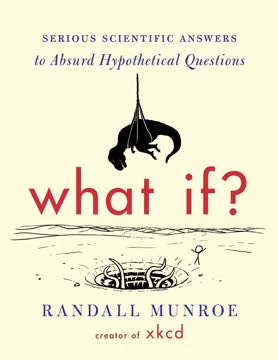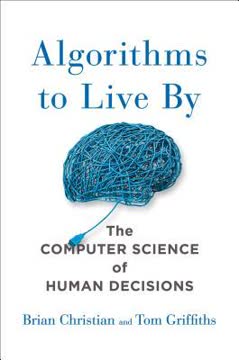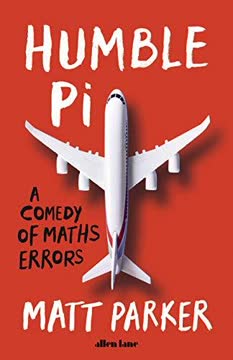النقاط الرئيسية
1. الألغاز المنطقية تصقل مهارات الاستدلال الاستنباطي وحل المشكلات
المنطق. من المنطقي أن نبدأ من هنا: الاستدلال المنطقي هو القاعدة الأساسية لكل الألغاز الرياضية.
الأسس المنطقية. تشكل الألغاز المنطقية حجر الأساس في حل المشكلات الرياضية. فهي تدرب العقل على تحليل المعلومات بشكل منهجي، واستخلاص استنتاجات صحيحة، والوصول إلى نتائج سليمة. من الأمثلة الكلاسيكية:
- ألغاز عبور النهر (مثل الذئب، الماعز، والكرنب)
- ألغاز الصادق والكاذب
- ألغاز الاستنتاج القائمة على الشبكات (مثل لغز أينشتاين)
التطبيقات العملية. المهارات التي تُنمّى من خلال الألغاز المنطقية تتجاوز الرياضيات الترفيهية بكثير. فهي ضرورية في:
- برمجة الحاسوب وتصميم الخوارزميات
- التفكير القانوني والحجج القضائية
- اختبار الفرضيات العلمية
- التخطيط الاستراتيجي في الأعمال والسياسة
2. الألغاز الهندسية تكشف خصائص مدهشة للأشكال والفضاءات
كتاب "العناصر" يبدو ظاهريًا عن الهندسة، أي سلوك النقاط والخطوط والأسطح والأجسام الصلبة. لكن أهميته الحقيقية في تاريخ الفكر البشري كانت في الطريقة التي قدمها إقليدس لاستكشاف هذه المفاهيم.
الأسس الإقليدية. تبني الألغاز الهندسية على النظام البديهي الذي وضعه إقليدس، مستكشفة خصائص الأشكال والعلاقات المكانية. من المفاهيم الأساسية:
- بناء الأشكال باستخدام أدوات بسيطة (مثل المسطرة والفرجار فقط)
- استكشاف التناظر والتحولات
- دراسة المساحة والحجم وخصائص مكانية أخرى
نتائج غير بديهية. تؤدي العديد من الألغاز الهندسية إلى استنتاجات مفاجئة تتحدى فهمنا الحدسي للمكان:
- لغز "الحبل حول الأرض" الذي يوضح كيف يمكن لزيادة صغيرة في المحيط أن تخلق ارتفاعًا كبيرًا
- ألغاز تتعلق بدحرجة الدوائر والعجلات، تكشف عن خصائص حركة غير متوقعة
- ألغاز التانغرام التي تظهر كيف يمكن إعادة ترتيب الأشكال بطرق غير واضحة
3. الألغاز العددية تكشف أنماطًا وعلاقات مذهلة
الأعداد يمكن أن تصف الكميات. فقرة واحدة. ست كلمات. ثلاث جمل. لكن عندما تكون الأعداد في قائمة، يمكنها أيضًا التعبير عن ترتيب.
العلاقات العددية. تكشف الألغاز العددية الشبكة المعقدة من العلاقات بين الأعداد الصحيحة، والكسور، وغيرها من التركيبات العددية. وغالبًا ما تشمل:
- الأعداد الأولية والتحليل إلى عوامل
- قواعد القسمة ومفاهيم نظرية الأعداد
- المتتاليات والمتسلسلات
التعرف على الأنماط. تدرب العديد من الألغاز العددية العقل على التعرف على الأنماط واستنتاجها:
- المربعات السحرية وترتيبات مماثلة
- متتاليات عددية ذات قواعد مخفية
- ألغاز تتعلق بالجذور الرقمية أو تحولات عددية أخرى
4. الألغاز العملية تطبق التفكير الرياضي على سيناريوهات الحياة الواقعية
الرياضيات وأغلب الطيور
التطبيقات الواقعية. تجسر الألغاز العملية الفجوة بين الرياضيات المجردة وحل المشكلات اليومية. وغالبًا ما تشمل:
- مسائل تحسين (مثل لغز "مئة طائر")
- الاحتمالات والإحصاء في سياقات الحياة الواقعية
- تحديات القياس وتحويل الوحدات
السياق التاريخي. تحمل العديد من الألغاز العملية خلفيات تاريخية غنية:
- مسائل التجارة والتبادل في العصور القديمة
- ألغاز نشأت من تحديات الملاحة وحساب الوقت
- مسائل مستوحاة من القمار وألعاب الحظ
5. الألغاز المعتمدة على الأدوات توفر تفاعلًا عمليًا مع المفاهيم الرياضية
الألغاز التي تتطلب اللعب بأشياء حقيقية قد تكون من أكثر الترفيهات الرياضية جذبًا.
التعلم الحسي. تقدم الألغاز المعتمدة على الأدوات نهجًا عمليًا لفهم المفاهيم الرياضية، مما يجعلها أكثر سهولة وجاذبية. من الأدوات الشائعة:
- العملات لاستكشاف الاحتمالات والتوافيق
- أعواد الثقاب للهندسة والتعرف على الأنماط
- الخيوط والورق لألغاز الطوبولوجيا
التفكير المكاني. تطور العديد من الألغاز المعتمدة على الأدوات مهارات التفكير المكاني:
- التانغرام وألغاز التفكيك الأخرى
- ألغاز التجميع ثلاثية الأبعاد
- ألغاز نظرية العقد باستخدام الخيوط أو الحبال
6. تاريخ الألغاز يعكس تطور الفكر الرياضي
"Propositiones" وثيقة رائعة. إنها أكبر مجموعة من الألغاز من العصور الوسطى، وأول نص لاتيني يحتوي على مادة رياضية أصلية.
التطور التاريخي. يعكس تاريخ الألغاز الرياضية تطور التفكير الرياضي:
- الحضارات القديمة: ألغاز العد والقياس الأساسية
- العصور الوسطى: تعقيد متزايد في ألغاز الجبر والهندسة
- عصر النهضة والتنوير: ألغاز تعكس تقدمات في حساب التفاضل والتكامل ونظرية الاحتمالات
- العصر الحديث: ألغاز تدمج علوم الحاسوب والمفاهيم الرياضية المتقدمة
التبادل الثقافي. غالبًا ما كانت الألغاز وسيلة لنشر الأفكار الرياضية عبر الثقافات:
- رحلة مسألة "مئة طائر" من الصين إلى أوروبا
- الانتشار العالمي للمربعات السحرية وترتيبات الأعداد المشابهة
- الشعبية الدولية للألغاز المنطقية اليابانية مثل السودوكو
7. الألغاز تعزز التفكير الإبداعي ونهج حل المشكلات الجانبي
المفتاح هنا هو أن تدع عقلك المنطقي يتغلب على حدسك الفطري.
كسر الحواجز الذهنية. صُممت العديد من الألغاز لتحدي التفكير التقليدي وتشجيع الحلول الإبداعية:
- ألغاز تحتوي على معلومات مضللة أو غير ذات صلة
- مسائل تتطلب "التفكير خارج الصندوق"
- ألغاز ذات حلول متعددة أو تحولات غير متوقعة
التفكير الجانبي. غالبًا ما يتطلب حل الألغاز الاقتراب من المشكلات من زوايا غير تقليدية:
- إعادة صياغة المشكلة في سياق مختلف
- استخدام التصور أو الاستعارات لاكتساب رؤى جديدة
- دمج معلومات متفرقة بطرق مبتكرة
8. للألغاز الرياضية تطبيقات تتجاوز الترفيه البحت
الألغاز جذابة لأنها تلبي الدافع البشري لفهم العالم؛ تمنحنا متعة لأننا نُحاول أن نفهم شيئًا ما.
القيمة التعليمية. تعد الألغاز أدوات تعليمية قوية في تعليم الرياضيات:
- تقديم مفاهيم معقدة بطريقة مشوقة
- توفير تدريب على استراتيجيات حل المشكلات
- إظهار الترابط بين مجالات الرياضيات المختلفة
التطبيقات المهنية. تستخدم العديد من المجالات مسائل شبيهة بالألغاز في عملها:
- علوم الحاسوب: تصميم الخوارزميات وتحسينها
- المالية: تقييم المخاطر وتوقع الأسواق
- الهندسة: استكشاف الأخطاء وتصميم الأنظمة
- علم النفس: اختبارات الإدراك وتدريب الدماغ
آخر تحديث::
FAQ
What is "Can You Solve My Problems?" by Alex Bellos about?
- Curated puzzle collection: The book is a curated anthology of 125 mathematical and logical puzzles spanning the last two millennia, selected by Alex Bellos for their ingenuity, entertainment, and thought-provoking qualities.
- Wide-ranging puzzle types: It covers a broad spectrum of puzzle types, including logic, geometry, practical problems, prop-based puzzles, and number games, each with historical context and stories about their origins.
- Accessible to all: The puzzles require logical thinking and creativity but do not demand advanced mathematical knowledge, making the book accessible to a general audience.
- Celebration of puzzle culture: Bellos explores the cultural, historical, and intellectual significance of puzzles, showing how they reflect mathematical discovery and human curiosity.
Why should I read "Can You Solve My Problems?" by Alex Bellos?
- Sharpen your mind: The book offers a fun and challenging way to exercise logical reasoning, problem-solving, and creative thinking skills.
- Learn puzzle history: Readers gain insight into the evolution of puzzles, their role in mathematics, and their cultural significance across different eras and societies.
- Enjoy diverse challenges: With puzzles ranging from ancient riddles to modern brainteasers, there’s something for every level and interest.
- Experience joy of discovery: Bellos emphasizes the pleasure and satisfaction that comes from solving puzzles, making the book both entertaining and intellectually rewarding.
What are the key takeaways from "Can You Solve My Problems?" by Alex Bellos?
- Puzzles as universal language: Puzzles transcend time and culture, offering a playful yet profound way to engage with mathematics and logic.
- Problem-solving strategies: The book demonstrates that many puzzles are difficult not because of their complexity, but because of the approach—sometimes a change in perspective is all that’s needed.
- Historical context matters: Understanding the origins and evolution of puzzles enriches the solving experience and highlights the creativity of past mathematicians and puzzle-makers.
- Fun and learning combined: The act of puzzling is both enjoyable and educational, expanding one’s toolkit for tackling real-life challenges.
How is "Can You Solve My Problems?" by Alex Bellos structured?
- Thematic chapters: The book is divided into chapters by puzzle type—Logic Problems, Geometry Problems, Practical Problems, Problems with Props, and Problems for Purists.
- Chronological order: Within each chapter, puzzles are presented roughly in chronological order, showing the development of puzzle styles and themes over time.
- Difficulty varies: Puzzles are not ordered by difficulty, as what is hard for one person may be easy for another; some are marked as especially tough.
- Quick-fire teasers: Each chapter begins with ten short, themed questions (often from UK Mathematics Trust competitions) to warm up the reader.
What kinds of puzzles are included in "Can You Solve My Problems?" by Alex Bellos?
- Classic logic puzzles: River crossings, truth-tellers and liars, kinship riddles, and deduction-based mysteries.
- Geometric challenges: Problems involving shapes, areas, and spatial reasoning, often inspired by historical texts and Japanese sangaku.
- Practical and real-world puzzles: Scenarios involving coins, weights, jugs, and everyday objects, often requiring clever reasoning or algebraic thinking.
- Prop-based and hands-on puzzles: Tasks using coins, matches, stamps, and string, encouraging physical manipulation and experimentation.
- Number games and purist puzzles: Problems focused on arithmetic, number patterns, and mathematical properties, including the famous "four fours" challenge.
What is Alex Bellos’s approach to teaching problem-solving in "Can You Solve My Problems?"?
- Emphasis on reasoning: Bellos encourages step-by-step logical deduction, often walking the reader through the reasoning process for selected puzzles.
- Highlighting misdirection: He shows how many puzzles are designed to lead solvers down the wrong path, teaching the importance of questioning assumptions.
- Encouraging playfulness: The book celebrates intellectual play, curiosity, and the joy of discovery, rather than rote calculation or memorization.
- Learning from failure: Bellos suggests that even when a puzzle is not solved, the solution can be as enlightening as the process, often revealing new techniques or ideas.
What are some of the most famous or historically significant puzzles featured in "Can You Solve My Problems?" by Alex Bellos?
- Wolf, Goat, and Cabbages: An ancient river-crossing puzzle from Alcuin’s "Problems to Sharpen the Young."
- The Zebra Puzzle (Einstein’s Riddle): A complex logic grid puzzle about houses, nationalities, and pets.
- Cheryl’s Birthday: A viral logic puzzle from a Singaporean math competition, famous for its shared-knowledge reasoning.
- The Four Fours: A classic number puzzle challenging solvers to express numbers using exactly four 4s and mathematical operations.
- The 7-Eleven Problem: A modern algebraic puzzle involving prices and products, illustrating the power of prime factorization.
How does "Can You Solve My Problems?" by Alex Bellos connect puzzles to mathematical history and culture?
- Historical anecdotes: Each puzzle is accompanied by stories about its origin, evolution, and the mathematicians or cultures that popularized it.
- Cultural adaptations: Bellos shows how classic puzzles have been adapted across regions and eras, reflecting local customs and concerns.
- Mathematics as recreation: The book highlights how, historically, mathematics was often pursued for amusement and intellectual diversion, not just practical calculation.
- Influence on mathematics: Some puzzles have inspired significant mathematical discoveries or have been used to teach important concepts.
What advice does Alex Bellos give for solving puzzles in "Can You Solve My Problems?"?
- Don’t assume the obvious: Many puzzles are designed to mislead; always question your initial assumptions and look for alternative interpretations.
- Use logical elimination: Systematically ruling out possibilities is often key, especially in grid-based or deduction puzzles.
- Draw diagrams and grids: Visual aids can clarify relationships and help organize information, especially for complex logic or spatial puzzles.
- Enjoy the process: Bellos encourages solvers to embrace the challenge, learn from mistakes, and find satisfaction in both the struggle and the solution.
What are some of the best quotes from "Can You Solve My Problems?" by Alex Bellos and what do they mean?
- "The best puzzles are pieces of poetry." — Bellos emphasizes the elegance, brevity, and beauty of well-crafted puzzles, likening them to art.
- "Often a problem is difficult not because it is a ‘difficult problem’ but because we are going about it the wrong way." — This highlights the importance of perspective and approach in problem-solving.
- "Puzzles are captivating because they appeal to the human impulse to make sense of the world; they give us pleasure because we are making sense out of something." — Bellos connects the joy of puzzling to a fundamental human drive for understanding.
- "Most importantly, however, puzzles indulge our intellectual playfulness. They are fun. They reflect a childlike sense of curiosity." — The book celebrates the playful, joyful side of mathematics and logic.
How does "Can You Solve My Problems?" by Alex Bellos help readers improve their problem-solving skills?
- Exposure to variety: By presenting a wide range of puzzle types, the book broadens the reader’s repertoire of strategies and approaches.
- Step-by-step solutions: For selected puzzles, Bellos provides detailed reasoning, modeling effective problem-solving techniques.
- Encouragement of persistence: The book normalizes struggle and failure as part of the learning process, encouraging readers to keep trying.
- Transferable skills: The logical, creative, and analytical skills developed through puzzling are applicable to real-world challenges and other areas of life.
What makes "Can You Solve My Problems?" by Alex Bellos unique among puzzle books?
- Curatorial expertise: Bellos’s selection is informed by deep research, correspondence with puzzle experts, and a passion for mathematical history.
- Storytelling approach: Each puzzle is contextualized with engaging stories, making the book as much about the culture of puzzling as the puzzles themselves.
- Balance of challenge and accessibility: The book is designed to be approachable for non-mathematicians while still offering depth and challenge for experienced solvers.
- Celebration of play: Bellos’s infectious enthusiasm for puzzles and intellectual playfulness sets the tone, making the book both educational and delightful.
مراجعات
هل تستطيع حل مشكلاتي؟ هو كتاب أحاجي نال استحسان القراء، لما يحتويه من مجموعة متنوعة من الألغاز التي تحفز العقل، إلى جانب سياق تاريخي شيق يثري التجربة. يثمن القراء تنوع مستويات الصعوبة، والشروحات المفصلة، وحماس المؤلف للألغاز. يجد الكثيرون أن الكتاب مناسب لجميع الأعمار، ويعد وسيلة ممتازة لتنشيط التفكير النقدي. يشير بعض المراجعين إلى أن الاستمتاع به يكون أفضل في النسخة المطبوعة، ويفضلون استخدامه كاستراحة ذهنية بين الحين والآخر بدلاً من قراءته دفعة واحدة. بينما وجد بعضهم أن بعض الألغاز إما بسيطة جدًا أو معقدة للغاية، إلا أن الكتاب يحظى بتوصية قوية من محبي الألغاز بشكل عام.
Similar Books















